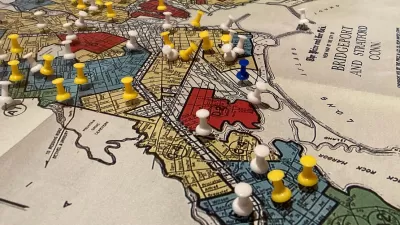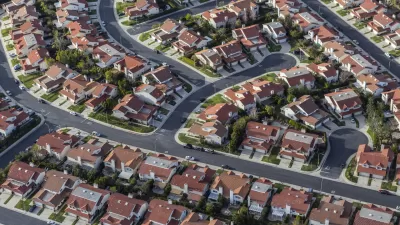The ugly story of the fence between a public housing community called New Haven and the nearby "middle class" community of Hamden, Connecticut will soon be over, but not because Hamden suddenly gained enlightenment.
"[Dillard Bennett's] family moved to New Haven from Georgia in 1959, seeking an escape from segregated buses and racial violence. Instead, they found what Mr. Bennett, who is black, called a signal that 'hatred for black folks' endures: 1,500 feet of thickly woven metal, enclosing a cluster of public housing projects on three sides," reports Benjamin Mueller.
Beyond it's literal presence, the fence also has a strong symbolic effect as a border between two worlds. "Built by Hamden in the 1950s to keep crime out of an aspiring middle-class neighborhood, the fence choked off access to jobs for public housing residents and obstructed emergency responders. Anger festered in the projects, and unemployment rates surpassed 75 percent. By 1990, New Haven’s violent crime rate nearly tripled the national average. Rocks sometimes flew over the fence, once battering a Hamden school bus."
But that's about to change, because recently "excavators began tearing down parts of the fence to make way for three roads that will eventually connect the public housing projects to Hamden — the first breach in this border in half a century. The first road is expected to poke through by September."
Unfortunately, the fence is not coming down out of the goodness of Hamden hearts. Rather, the Department of Housing and Urban Development discovered, after an investigation onto discriminatory housing practices, that the fence is actually on New Haven property, which is allowing the fence to come down despite the passionate protests of Hamden's residents.
FULL STORY: In Connecticut, Breaking Barrier Between a Suburb and Public Housing

Alabama: Trump Terminates Settlements for Black Communities Harmed By Raw Sewage
Trump deemed the landmark civil rights agreement “illegal DEI and environmental justice policy.”

Planetizen Federal Action Tracker
A weekly monitor of how Trump’s orders and actions are impacting planners and planning in America.

The 120 Year Old Tiny Home Villages That Sheltered San Francisco’s Earthquake Refugees
More than a century ago, San Francisco mobilized to house thousands of residents displaced by the 1906 earthquake. Could their strategy offer a model for the present?

In Both Crashes and Crime, Public Transportation is Far Safer than Driving
Contrary to popular assumptions, public transportation has far lower crash and crime rates than automobile travel. For safer communities, improve and encourage transit travel.

Report: Zoning Reforms Should Complement Nashville’s Ambitious Transit Plan
Without reform, restrictive zoning codes will limit the impact of the city’s planned transit expansion and could exclude some of the residents who depend on transit the most.

Judge Orders Release of Frozen IRA, IIJA Funding
The decision is a victory for environmental groups who charged that freezing funds for critical infrastructure and disaster response programs caused “real and irreparable harm” to communities.
Urban Design for Planners 1: Software Tools
This six-course series explores essential urban design concepts using open source software and equips planners with the tools they need to participate fully in the urban design process.
Planning for Universal Design
Learn the tools for implementing Universal Design in planning regulations.
Clanton & Associates, Inc.
Jessamine County Fiscal Court
Institute for Housing and Urban Development Studies (IHS)
City of Grandview
Harvard GSD Executive Education
Toledo-Lucas County Plan Commissions
Salt Lake City
NYU Wagner Graduate School of Public Service





























